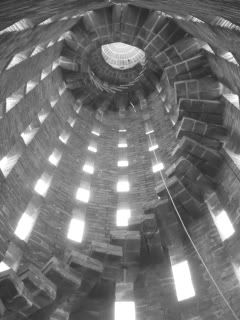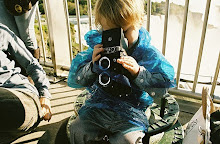Only Bleeding

Eladio Dieste: The resistant virtues of the structure that we make depend on their form; it is through their form that they are stable and not because of an awkward accumulation of materials. There is nothing more noble and elegant from an intellectual viewpoint than this; resistance through form.
Nicolai Ourossoff of the NYT on the new Times building: Even so, you never feel that the building embraces the future wholeheartedly. Rather than move beyond the past, Mr. Piano has fine-tuned it.
Ourossoff on the new New Museum: But not since the Museum of Modern Art rattled the foundations of the city’s art establishment in the 1930s has a museum seemed so in touch with the present.
In my neighborhood, someone has spray-painted the outlines the shadows of objects on the sidewalks--such as stop signs or fire hydrants--cast at certain times of the day. Every once in a while, when i'm crossing the street to the laundromat or walking to work, the shadow fits exactly inside its trace, and you wouldn't believe how happy this makes people. i've seen whole families stop and point, smiles all around. The scribbles they step over every day suddenly make sense, and the combination of form and content is an oddly satisfying communion. i could go on about impossible fixity and the stories we tell ourselves, but that would be coming from someone who has the word trace tattoed on her arm, which is basically the same gesture as the one made by this sidewalk artist: hopeful nostalgia.
Svetlana Boym's Future of Nostalgia offers a more succinct parsing of nostalgia into two categories: reflective and restorative. Reflective nostalgia is "grounded in longing, contemplating, and remembering," but importantly is not a restorative attempt. "It's a positive force that helps us explore our experience, and can offer an alternative to an uncritical acceptance of the present." Restorative nostalgia, however, often attempts to restore a fantasized lost tradition in order to mythologize the past.
I'm Not There, the new film by Todd Haynes, is an exercise in (hopeful) reflective nostalgia. The film's title declares its polemicization of the fantasy of the self-same subject. By refusing biographical veracity or completeness, Haynes isolates the allure of the Dylan metamorphosis: he illustrates the difficulty of the attempt to give form to the total bind of desire. The film proposes that Dylan's startling admission that 'there is no sense in trying' is much more complicated than nihilism. I'm Not There suggests that Dylan came to this acknowledgement precisely through trying, and by recognizing the complications of resistance. That he also turned, like many contemporary critical thinkers, to the question of desire, does not mean that he opted out of politics. It means he became more careful. His philandering between god/no god, one woman/tons of women, freedom-fighting/self-absorption, might make us uncomfortable, but this waffling is actually a kind of consistency. In interviews Haynes explains his preoccupation with Dylan's interstitial subjectivity as a larger interest in androgyny; however, a more precise way of wording this is to say that Dylan's iconoclastic masculinity upsets conventional sex/gender correlations, and Haynes's choice to have an actor audiences will read as female portray Dylan at what could be argued to be his most radical period underlines this disruption/admission of necessary ambivalence.
The film renounces first person perspective in order to position this narrative as an insistent challenge to conventional biography. The multiple fantastic narratives are a concession to the extreme difficulty of representation, something Dylan's music, celebrity, and "private" life all suggest. Rather than idolizing the myth of the genius individual, Haynes rewrites Dylan in order to productively mobilize the potentially productive possibility of (Dylan) nostalgia.
Bob Dylan, made by Haynes into a metonym for the (post)modern condition, is at once a conduit for engaged nostalgia and the (im)possibility of the new, or, non-complicit resistance. The film presents its argument by fragmenting one "character" into six. The combined alter-Dylans of Marcus Carl Franklin/Woody Guthrie and Richard Gere/Billy the Kid (nostalgia), Ben Whishaw/Arthur Rimbaud (self-reflection), Christian Bale/Jack Rollins (failure), Heath Ledger/Robbie Clark (desire), and Cate Blanchett/Jude Quinn (the new) suggest the problem with conventional forms of biography: they assert an impossible cohesiveness. Haynes sidesteps this problem by creating a film that uses its nostalgia to re-orient its viewers to their own present, rather than trying to recreate an irretrievable past.
A politics of reflective nostalgia would account both for the pleasure of seeing a shadow neatly confined by its outline and for the necessarily brief nature of this exchange. The gaps, waiting, and complete loss of control acute feelings of desire are bound to elicit enact an undoing of the self, a blurring of what or who "I" was before "you" exposed to me to my lack of boundaries. Haynes's rewriting of Dylan in order to tell a story about desire enacts, if we use Boym's model, a reflective engagement with nostalgia.

